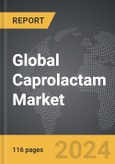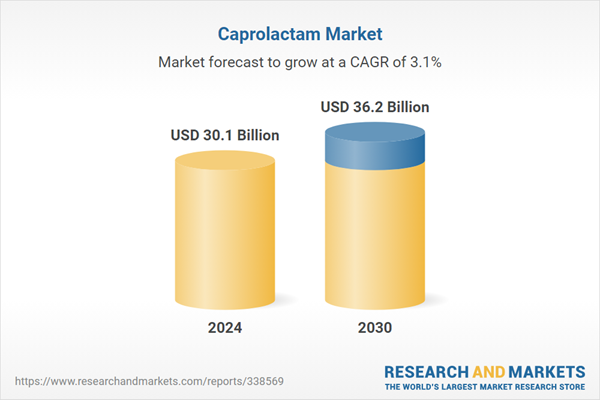The global market for Caprolactam was valued at US$30.1 Billion in 2024 and is projected to reach US$36.2 Billion by 2030, growing at a CAGR of 3.1% from 2024 to 2030. This comprehensive report provides an in-depth analysis of market trends, drivers, and forecasts, helping you make informed business decisions. The report includes the most recent global tariff developments and how they impact the Caprolactam market.
Segments: Application (Nylon 6 Fibers, Nylon 6 Resins); End-Use (Textile Yarn, Industrial Yarn, Engineering Plastics, Carpet Fibers & Staple Fibers).
Geographic Regions/Countries: World; United States; Canada; Japan; China; Europe (France; Germany; Italy; United Kingdom; Spain; Russia; and Rest of Europe); Asia-Pacific (Australia; India; South Korea; and Rest of Asia-Pacific); Latin America (Argentina; Brazil; Mexico; and Rest of Latin America); Middle East (Iran; Israel; Saudi Arabia; United Arab Emirates; and Rest of Middle East); and Africa.
The analysts continuously track trade developments worldwide, drawing insights from leading global economists and over 200 industry and policy institutions, including think tanks, trade organizations, and national economic advisory bodies. This intelligence is integrated into forecasting models to provide timely, data-driven analysis of emerging risks and opportunities.
Global Caprolactam Market - Key Trends & Drivers Summarized
What Is Caprolactam and Why Is It Important?
Caprolactam is a key chemical intermediate used in the production of nylon 6, a versatile polymer with applications in textiles, engineering plastics, and films. This cyclic amide, derived from cyclohexane or phenol, undergoes polymerization to form nylon 6, which is renowned for its strength, durability, and resistance to abrasion and chemicals. The textile industry utilizes nylon 6 fibers in the manufacture of clothing, carpets, and industrial fabrics due to their excellent mechanical properties and dyeability. In the automotive and electrical industries, nylon 6 is used to produce engineering plastics that offer high performance in terms of thermal stability, impact resistance, and dimensional stability, making caprolactam an essential component in modern manufacturing.How Is Caprolactam Utilized in Different Industries?
The applications of caprolactam extend across various industries, reflecting its versatility and importance. In the textile industry, nylon 6 fibers are used to produce a wide range of products, including apparel, hosiery, upholstery, and industrial fabrics, benefiting from their strength, elasticity, and aesthetic qualities. The automotive industry employs nylon 6 in the production of parts such as engine covers, oil pans, and radiator fans, where its high strength-to-weight ratio and thermal resistance enhance vehicle performance and fuel efficiency. The packaging industry utilizes nylon 6 films for food packaging, medical devices, and industrial products, taking advantage of its barrier properties and puncture resistance. These diverse applications underscore the critical role of caprolactam in supporting various industrial processes and end-products.What Are the Environmental and Health Considerations?
The production and use of caprolactam involve environmental and health considerations that must be addressed to ensure sustainability. The synthesis of caprolactam from cyclohexane or phenol involves energy-intensive processes and the use of hazardous chemicals, posing occupational health risks and environmental challenges. The release of caprolactam into the environment can lead to water and soil contamination, affecting ecosystems and biodiversity. To mitigate these impacts, industries are adopting cleaner production technologies, improving process efficiency, and implementing waste management practices. Regulatory frameworks and international standards are being enforced to ensure responsible manufacturing and minimize the environmental footprint of caprolactam production and utilization.What Is Driving the Growth in the Caprolactam Market?
The growth in the caprolactam market is driven by several factors, including increasing demand for nylon 6, technological advancements, and expanding applications in various industries. The rising demand for durable and lightweight materials in the automotive and electronics sectors is a major driver for caprolactam consumption. The growth of the textile industry, particularly in emerging economies, is boosting the demand for nylon 6 fibers. Technological advancements in polymerization and production processes have enhanced the efficiency and quality of caprolactam, making it more cost-effective and environmentally friendly. Additionally, the development of bio-based caprolactam and efforts to enhance sustainability in the chemical industry are shaping the market landscape. These drivers highlight the dynamic and evolving nature of the caprolactam market, emphasizing the balance between industrial demands and environmental sustainability.Report Scope
The report analyzes the Caprolactam market, presented in terms of units. The analysis covers the key segments and geographic regions outlined below.Segments: Application (Nylon 6 Fibers, Nylon 6 Resins); End-Use (Textile Yarn, Industrial Yarn, Engineering Plastics, Carpet Fibers & Staple Fibers).
Geographic Regions/Countries: World; United States; Canada; Japan; China; Europe (France; Germany; Italy; United Kingdom; Spain; Russia; and Rest of Europe); Asia-Pacific (Australia; India; South Korea; and Rest of Asia-Pacific); Latin America (Argentina; Brazil; Mexico; and Rest of Latin America); Middle East (Iran; Israel; Saudi Arabia; United Arab Emirates; and Rest of Middle East); and Africa.
Key Insights:
- Market Growth: Understand the significant growth trajectory of the Nylon 6 Fibers segment, which is expected to reach US$16.5 Billion by 2030 with a CAGR of a 2.6%. The Nylon 6 Resins segment is also set to grow at 3.6% CAGR over the analysis period.
- Regional Analysis: Gain insights into the U.S. market, valued at $8.1 Billion in 2024, and China, forecasted to grow at an impressive 5.1% CAGR to reach $7.1 Billion by 2030. Discover growth trends in other key regions, including Japan, Canada, Germany, and the Asia-Pacific.
Why You Should Buy This Report:
- Detailed Market Analysis: Access a thorough analysis of the Global Caprolactam Market, covering all major geographic regions and market segments.
- Competitive Insights: Get an overview of the competitive landscape, including the market presence of major players across different geographies.
- Future Trends and Drivers: Understand the key trends and drivers shaping the future of the Global Caprolactam Market.
- Actionable Insights: Benefit from actionable insights that can help you identify new revenue opportunities and make strategic business decisions.
Key Questions Answered:
- How is the Global Caprolactam Market expected to evolve by 2030?
- What are the main drivers and restraints affecting the market?
- Which market segments will grow the most over the forecast period?
- How will market shares for different regions and segments change by 2030?
- Who are the leading players in the market, and what are their prospects?
Report Features:
- Comprehensive Market Data: Independent analysis of annual sales and market forecasts in US$ Million from 2024 to 2030.
- In-Depth Regional Analysis: Detailed insights into key markets, including the U.S., China, Japan, Canada, Europe, Asia-Pacific, Latin America, Middle East, and Africa.
- Company Profiles: Coverage of players such as Aareydrugs & Pharmaceuticals Ltd., Basf Canada Inc., BASF SE, Capro Corporation, Caprolactam Chemicals and more.
- Complimentary Updates: Receive free report updates for one year to keep you informed of the latest market developments.
Some of the 36 companies featured in this Caprolactam market report include:
- Aareydrugs & Pharmaceuticals Ltd.
- Basf Canada Inc.
- BASF SE
- Capro Corporation
- Caprolactam Chemicals
- Central Drug House (P) Ltd.
- Chematur Engineering AB
- DOMO Chemicals GmbH
- Enka de Colombia SA
- Envalior GmbH
Tariff Impact Analysis: Key Insights for 2025
Global tariff negotiations across 180+ countries are reshaping supply chains, costs, and competitiveness. This report reflects the latest developments as of April 2025 and incorporates forward-looking insights into the market outlook.The analysts continuously track trade developments worldwide, drawing insights from leading global economists and over 200 industry and policy institutions, including think tanks, trade organizations, and national economic advisory bodies. This intelligence is integrated into forecasting models to provide timely, data-driven analysis of emerging risks and opportunities.
What’s Included in This Edition:
- Tariff-adjusted market forecasts by region and segment
- Analysis of cost and supply chain implications by sourcing and trade exposure
- Strategic insights into geographic shifts
Buyers receive a free July 2025 update with:
- Finalized tariff impacts and new trade agreement effects
- Updated projections reflecting global sourcing and cost shifts
- Expanded country-specific coverage across the industry
Table of Contents
I. METHODOLOGYII. EXECUTIVE SUMMARY2. FOCUS ON SELECT PLAYERSIII. MARKET ANALYSISSOUTH KOREAREST OF ASIA-PACIFICARGENTINABRAZILMEXICOREST OF LATIN AMERICAIRANISRAELSAUDI ARABIAUNITED ARAB EMIRATESREST OF MIDDLE EASTIV. COMPETITION
1. MARKET OVERVIEW
3. MARKET TRENDS & DRIVERS
4. GLOBAL MARKET PERSPECTIVE
UNITED STATES
CANADA
JAPAN
CHINA
EUROPE
FRANCE
GERMANY
ITALY
UNITED KINGDOM
SPAIN
RUSSIA
REST OF EUROPE
ASIA-PACIFIC
AUSTRALIA
INDIA
LATIN AMERICA
MIDDLE EAST
AFRICA
Companies Mentioned (Partial List)
A selection of companies mentioned in this report includes, but is not limited to:
- Aareydrugs & Pharmaceuticals Ltd.
- Basf Canada Inc.
- BASF SE
- Capro Corporation
- Caprolactam Chemicals
- Central Drug House (P) Ltd.
- Chematur Engineering AB
- DOMO Chemicals GmbH
- Enka de Colombia SA
- Envalior GmbH
Table Information
| Report Attribute | Details |
|---|---|
| No. of Pages | 116 |
| Published | April 2025 |
| Forecast Period | 2024 - 2030 |
| Estimated Market Value ( USD | $ 30.1 Billion |
| Forecasted Market Value ( USD | $ 36.2 Billion |
| Compound Annual Growth Rate | 3.1% |
| Regions Covered | Global |









